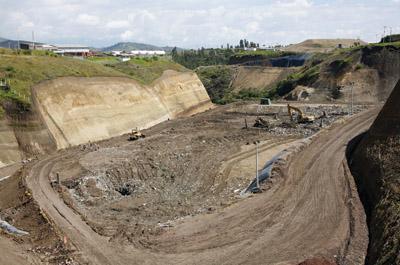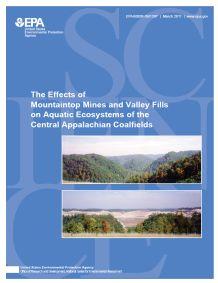EPA Science Matters Newsletter: Aquatic Ecosystems and Mountaintop Mining: Studying the Connections (Published January 2014)

EPA researchers provide the science needed to protect Appalachian streams.
Concerns about mountaintop mining stretch beyond the stark visual contrasts they create between mountain vistas and large-scale mining scenes. A number of ecological impacts surround them too, particularly the effects that mountaintop removal operations and related activities have on water quality, even far downstream.
A growing body of scientific literature, including numerous studies and scientific assessments conducted by EPA researchers, shows significant damage to streams polluted with storm water runoff flowing over mountaintop mining operations.
Burying small headwater streams with crushed rock removed from mining operations ("valley fills") can cause their permanent loss. Where they exist, these ecosystems play critical roles in the stability of aquatic food webs and other ecological processes, such as the cycling and flow of nutrients between the environment and living organisms. In the Appalachian region, when headwater streams are buried, habitats that had supported abundant and diverse types of aquatic organisms indigenous to the area are lost.
In addition, the removal of natural vegetation and physical changes to the soil and topography leads to changes in water runoff, flow, and quality. Water that flows over and through valleys burdened with fill from mining operations dissolves and elevates concentrations of chemical ions (salts) and other substances that can be harmful to aquatic organisms.
Two final reports released by EPA researchers present extensive assessments of the science exploring the impacts that mountaintop mining operations have on aquatic ecosystems: The Effects of Mountaintop Mines and Valley Fills on Aquatic Ecosystems of the Central Appalachian Coalfields, and A Field-Based Aquatic Life Benchmark for Conductivity in Central Appalachian Streams.
- Assessing Ecological Impacts

The Effects of Mountaintop Mines and Valley Fills on Aquatic Ecosystems of the Central Appalachian Coalfields provides a state-of-the-science assessment on the ecological impacts of mountaintop mining and valley fill operations. EPA researchers identified and reviewed some 277 scientific sources, including peer-reviewed books, conference proceedings, journal articles, reports, theses and dissertations, and other sources to present a single-volume assessment of scientific studies on the aquatic impacts associated with mountaintop mining.
The final report reviews the scientific record relevant to six potential consequences of mountaintop mining and valley fill operations:
- Loss of headwater resources;
- Impacts on water quality;
- Impacts from aquatic toxicity;
- Impacts on aquatic ecosystems;
- Cumulative impacts of multiple mining operations; and
- Effectiveness of on-site reclamation and mitigation activities.
- Aquatic Life Benchmark

A Field-based Aquatic Life Benchmark for Conductivity in Central Appalachian Streams provides the scientific basis for using conductivity (a measure of the concentration of salts) as the benchmark for water quality necessary to protect aquatic organisms living in Appalachian surface waters.
Because mountaintop mining operations can lead to elevated salinity levels in nearby streams, measuring conductivity provides an indication of how those operations are impacting water quality.
EPA scientists analyzed more than 2,000 field samples to derive a conductivity benchmark that protects 95% of the genera (sets of similar and closely related species) of aquatic organisms living in streams in central Appalachia.
For more on the research behind the benchmark, please see the June, 2013 issue ofEnvironmental Toxicology and Chemistry, which presents a set of papers by EPA scientists on developing it for central Appalachian streams.
Together, the two final reports provide data and information needed to inform and support actions taken to protect Appalachian aquatic ecosystems. The science and assessments present water quality guidelines for sustaining populations of aquatic animals that together form the basis of stream food webs and ecosystem sustainability.
“These studies not only show that salts can be harmful, but that whole groups of species can no longer live in streams below valley fills,” said EPA author Susan Cormier, Ph.D. “Now that the effects and causes are clear, EPA, states, academics, and the mining sector are trying to find ways to minimize stream burial and the amount of salt released to streams so that fewer freshwaters and the life that lives in and near them are not permanently destroyed.”
The Agency’s Office of Water and its partners have used the reports and other Agency research to support actions taken to protect Appalachian water resources from the impacts of mountaintop mining under the Clean Water Act.
